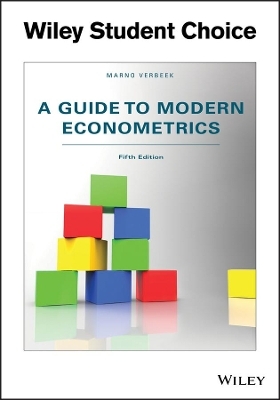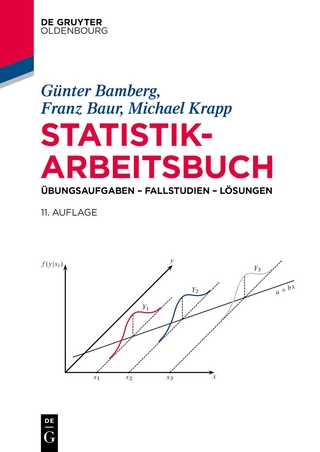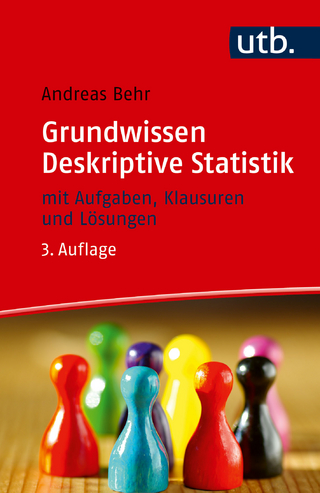
A Guide to Modern Econometrics 5th Edition
John Wiley & Sons Inc (Verlag)
978-1-119-40115-5 (ISBN)
MARNO VERBEEK is Professor of Finance at Rotterdam School of Management, Erasmus University (RSM). He held previous positions at KU Leuven and Tilburg University, and visiting appointments at Trinity College, Dublin and Université Panthéon-Assas Paris II. He has published in a wide variety of international journals, including Journal of Econometrics, Journal of Applied Econometrics, Management Science, Journal of Business and Economic Statistics, Review of Economics and Statistics, International Economic Review, and the Journal of Financial and Quantitative Analysis.
Preface xi
1 Introduction 1
1.1 About Econometrics 1
1.2 The Structure of This Book 3
1.3 Illustrations and Exercises 4
2 An Introduction to Linear Regression 6
2.1 Ordinary Least Squares as an Algebraic Tool 7
2.1.1 Ordinary Least Squares 7
2.1.2 Simple Linear Regression 9
2.1.3 Example: Individual Wages 11
2.1.4 Matrix Notation 11
2.2 The Linear Regression Model 12
2.3 Small Sample Properties of the OLS Estimator 15
2.3.1 The Gauss–Markov Assumptions 15
2.3.2 Properties of the OLS Estimator 16
2.3.3 Example: Individual Wages (Continued) 20
2.4 Goodness-of-Fit 20
2.5 Hypothesis Testing 23
2.5.1 A Simple t-Test 23
2.5.2 Example: Individual Wages (Continued) 25
2.5.3 Testing One Linear Restriction 25
2.5.4 A Joint Test of Significance of Regression Coefficients 26
2.5.5 Example: Individual Wages (Continued) 28
2.5.6 The General Case 29
2.5.7 Size, Power and p-Values 30
2.5.8 Reporting Regression Results 32
2.6 Asymptotic Properties of the OLS Estimator 33
2.6.1 Consistency 33
2.6.2 Asymptotic Normality 35
2.6.3 Small Samples and Asymptotic Theory 37
2.7 Illustration: The Capital Asset Pricing Model 39
2.7.1 The CAPM as a Regression Model 40
2.7.2 Estimating and Testing the CAPM 41
2.7.3 The World’s Largest Hedge Fund 43
2.8 Multicollinearity 44
2.8.1 Example: Individual Wages (Continued) 47
2.9 Missing Data, Outliers and Influential Observations 48
2.9.1 Outliers and Influential Observations 48
2.9.2 Robust Estimation Methods 50
2.9.3 Missing Observations 51
2.10 Prediction 53
Wrap-up 54
Exercises 55
3 Interpreting and Comparing Regression Models 60
3.1 Interpreting the Linear Model 60
3.2 Selecting the Set of Regressors 65
3.2.1 Misspecifying the Set of Regressors 65
3.2.2 Selecting Regressors 66
3.2.3 Comparing Non-nested Models 71
3.3 Misspecifying the Functional Form 73
3.3.1 Nonlinear Models 73
3.3.2 Testing the Functional Form 74
3.3.3 Testing for a Structural Break 74
3.4 Illustration: Explaining House Prices 76
3.5 Illustration: Predicting Stock Index Returns 79
3.5.1 Model Selection 80
3.5.2 Forecast Evaluation 82
3.6 Illustration: Explaining Individual Wages 85
3.6.1 Linear Models 85
3.6.2 Loglinear Models 88
3.6.3 The Effects of Gender 91
3.6.4 Some Words of Warning 92
Wrap-up 93
Exercises 94
4 Heteroskedasticity and Autocorrelation 97
4.1 Consequences for the OLS Estimator 98
4.2 Deriving an Alternative Estimator 99
4.3 Heteroskedasticity 100
4.3.1 Introduction 100
4.3.2 Estimator Properties and Hypothesis Testing 103
4.3.3 When the Variances Are Unknown 104
4.3.4 Heteroskedasticity-consistent Standard Errors for OLS 105
4.3.5 Multiplicative Heteroskedasticity 106
4.3.6 Weighted Least Squares with Arbitrary Weights 107
4.4 Testing for Heteroskedasticity 108
4.4.1 Testing for Multiplicative Heteroskedasticity 108
4.4.2 The Breusch–Pagan Test 109
4.4.3 The White Test 109
4.4.4 Which Test? 110
4.5 Illustration: Explaining Labour Demand 110
4.6 Autocorrelation 114
4.6.1 First-order Autocorrelation 116
4.6.2 Unknown 𝜌 118
4.7 Testing for First-order Autocorrelation 119
4.7.1 Asymptotic Tests 119
4.7.2 The Durbin–Watson Test 120
4.8 Illustration: The Demand for Ice Cream 121
4.9 Alternative Autocorrelation Patterns 124
4.9.1 Higher-order Autocorrelation 124
4.9.2 Moving Average Errors 125
4.10 What to Do When You Find Autocorrelation? 126
4.10.1 Misspecification 126
4.10.2 Heteroskedasticity-and-autocorrelation-consistent Standard Errors for OLS 128
4.11 Illustration: Risk Premia in Foreign Exchange Markets 129
4.11.1 Notation 129
4.11.2 Tests for Risk Premia in the 1-Month Market 131
4.11.3 Tests for Risk Premia Using Overlapping Samples 134
Wrap-up 136
Exercises 136
5 Endogenous Regressors, Instrumental Variables and GMM 139
5.1 A Review of the Properties of the OLS Estimator 140
5.2 Cases Where the OLS Estimator Cannot Be Saved 143
5.2.1 Autocorrelation with a Lagged Dependent Variable 143
5.2.2 Measurement Error in an Explanatory Variable 144
5.2.3 Endogeneity and Omitted Variable Bias 146
5.2.4 Simultaneity and Reverse Causality 148
5.3 The Instrumental Variables Estimator 150
5.3.1 Estimation with a Single Endogenous Regressor and a Single Instrument 150
5.3.2 Back to the Keynesian Model 155
5.3.3 Back to the Measurement Error Problem 156
5.3.4 Multiple Endogenous Regressors 156
5.4 Illustration: Estimating the Returns to Schooling 157
5.5 Alternative Approaches to Estimate Causal Effects 162
5.6 The Generalized Instrumental Variables Estimator 163
5.6.1 Multiple Endogenous Regressors with an Arbitrary Number of Instruments 163
5.6.2 Two-stage Least Squares and the Keynesian Model Again 167
5.6.3 Specification Tests 168
5.6.4 Weak Instruments 169
5.6.5 Implementing and Reporting Instrumental Variables Estimators 170
5.7 Institutions and Economic Development 171
5.8 The Generalized Method of Moments 175
5.8.1 Example 175
5.8.2 The Generalized Method of Moments 177
5.8.3 Some Simple Examples 179
5.8.4 Weak Identification 180
5.9 Illustration: Estimating Intertemporal Asset Pricing Models 181
Wrap-up 184
Exercises 185
6 Maximum Likelihood Estimation and Specification Tests 187
6.1 An Introduction to Maximum Likelihood 188
6.1.1 Some Examples 188
6.1.2 General Properties 191
6.1.3 An Example (Continued) 194
6.1.4 The Normal Linear Regression Model 195
6.1.5 The Stochastic Frontier Model 197
6.2 Specification Tests 198
6.2.1 Three Test Principles 198
6.2.2 Lagrange Multiplier Tests 200
6.2.3 An Example (Continued) 203
6.3 Tests in the Normal Linear Regression Model 204
6.3.1 Testing for Omitted Variables 204
6.3.2 Testing for Heteroskedasticity 206
6.3.3 Testing for Autocorrelation 207
6.4 Quasi-maximum Likelihood and Moment Conditions Tests 208
6.4.1 Quasi-maximum Likelihood 208
6.4.2 Conditional Moment Tests 210
6.4.3 Testing for Normality 211
Wrap-up 212
Exercises 212
7 Models with Limited Dependent Variables 215
7.1 Binary Choice Models 216
7.1.1 Using Linear Regression? 216
7.1.2 Introducing Binary Choice Models 216
7.1.3 An Underlying Latent Model 219
7.1.4 Estimation 219
7.1.5 Goodness-of-Fit 221
7.1.6 Illustration: The Impact of Unemployment Benefits on Recipiency 223
7.1.7 Specification Tests in Binary Choice Models 226
7.1.8 Relaxing Some Assumptions in Binary Choice Models 228
7.2 Multiresponse Models 229
7.2.1 Ordered Response Models 230
7.2.2 About Normalization 231
7.2.3 Illustration: Explaining Firms’ Credit Ratings 231
7.2.4 Illustration: Willingness to Pay for Natural Areas 234
7.2.5 Multinomial Models 237
7.3 Models for Count Data 240
7.3.1 The Poisson and Negative Binomial Models 240
7.3.2 Illustration: Patents and R&D Expenditures 244
7.4 Tobit Models 246
7.4.1 The Standard Tobit Model 247
7.4.2 Estimation 249
7.4.3 Illustration: Expenditures on Alcohol and Tobacco (Part 1) 250
7.4.4 Specification Tests in the Tobit Model 253
7.5 Extensions of Tobit Models 256
7.5.1 The Tobit II Model 256
7.5.2 Estimation 259
7.5.3 Further Extensions 261
7.5.4 Illustration: Expenditures on Alcohol and Tobacco (Part 2) 262
7.6 Sample Selection Bias 265
7.6.1 The Nature of the Selection Problem 266
7.6.2 Semi-parametric Estimation of the Sample Selection Model 268
7.7 Estimating Treatment Effects 269
7.7.1 Regression-based Estimators 271
7.7.2 Regression Discontinuity Design 274
7.7.3 Weighting and Matching 276
7.8 Duration Models 278
7.8.1 Hazard Rates and Survival Functions 278
7.8.2 Samples and Model Estimation 281
7.8.3 Illustration: Duration of Bank Relationships 283
Wrap-up 284
Exercises 285
8 Univariate Time Series Models 288
8.1 Introduction 289
8.1.1 Some Examples 289
8.1.2 Stationarity and the Autocorrelation Function 291
8.2 General ARMA Processes 294
8.2.1 Formulating ARMA Processes 294
8.2.2 Invertibility of Lag Polynomials 297
8.2.3 Common Roots 298
8.3 Stationarity and Unit Roots 299
8.4 Testing for Unit Roots 301
8.4.1 Testing for Unit Roots in a First-order Autoregressive Model 301
8.4.2 Testing for Unit Roots in Higher-Order Autoregressive Models 304
8.4.3 Extensions 306
8.4.4 Illustration: Stock Prices and Earnings 307
8.5 Illustration: Long-run Purchasing Power Parity (Part 1) 309
8.6 Estimation of ARMA Models 313
8.6.1 Least Squares 314
8.6.2 Maximum Likelihood 315
8.7 Choosing a Model 316
8.7.1 The Autocorrelation Function 316
8.7.2 The Partial Autocorrelation Function 318
8.7.3 Diagnostic Checking 319
8.7.4 Criteria for Model Selection 319
8.8 Illustration: The Persistence of Inflation 320
8.9 Forecasting with ARMA Models 324
8.9.1 The Optimal Forecast 324
8.9.2 Forecast Accuracy 327
8.9.3 Evaluating Forecasts 329
8.10 Illustration: The Expectations Theory of the Term Structure 330
8.11 Autoregressive Conditional Heteroskedasticity 335
8.11.1 ARCH and GARCH Models 335
8.11.2 Estimation and Prediction 338
8.11.3 Illustration: Volatility in Daily Exchange Rates 340
8.12 What about Multivariate Models? 342
Wrap-up 343
Exercises 344
9 Multivariate Time Series Models 348
9.1 Dynamic Models with Stationary Variables 349
9.2 Models with Nonstationary Variables 352
9.2.1 Spurious Regressions 352
9.2.2 Cointegration 353
9.2.3 Cointegration and Error-correction Mechanisms 356
9.3 Illustration: Long-run Purchasing Power Parity (Part 2) 358
9.4 Vector Autoregressive Models 360
9.5 Cointegration: the Multivariate Case 364
9.5.1 Cointegration in a VAR 364
9.5.2 Example: Cointegration in a Bivariate VAR 366
9.5.3 Testing for Cointegration 367
9.5.4 Illustration: Long-run Purchasing Power Parity (Part 3) 370
9.6 Illustration: Money Demand and Inflation 372
Wrap-up 378
Exercises 379
10 Models Based on Panel Data 382
10.1 Introduction to Panel Data Modelling 383
10.1.1 Efficiency of Parameter Estimators 384
10.1.2 Identification of Parameters 385
10.2 The Static Linear Model 386
10.2.1 The Fixed Effects Model 386
10.2.2 The First-difference Estimator 388
10.2.3 The Random Effects Model 390
10.2.4 Fixed Effects or Random Effects? 394
10.2.5 Goodness-of-Fit 395
10.2.6 Alternative Instrumental Variables Estimators 396
10.2.7 Robust Inference 398
10.2.8 Testing for Heteroskedasticity and Autocorrelation 400
10.2.9 The Fama–MacBeth Approach 402
10.3 Illustration: Explaining Individual Wages 403
10.4 Dynamic Linear Models 405
10.4.1 An Autoregressive Panel Data Model 406
10.4.2 Dynamic Models with Exogenous Variables 411
10.4.3 Too Many Instruments 412
10.5 Illustration: Explaining Capital Structure 414
10.6 Panel Time Series 419
10.6.1 Heterogeneity 420
10.6.2 First Generation Panel Unit Root Tests 421
10.6.3 Second Generation Panel Unit Root Tests 424
10.6.4 Panel Cointegration Tests 425
10.7 Models with Limited Dependent Variables 426
10.7.1 Binary Choice Models 427
10.7.2 The Fixed Effects Logit Model 428
10.7.3 The Random Effects Probit Model 429
10.7.4 Tobit Models 431
10.7.5 Dynamics and the Problem of Initial Conditions 431
10.7.6 Semi-parametric Alternatives 433
10.8 Incomplete Panels and Selection Bias 433
10.8.1 Estimation with Randomly Missing Data 434
10.8.2 Selection Bias and Some Simple Tests 436
10.8.3 Estimation with Nonrandomly Missing Data 438
10.9 Pseudo Panels and Repeated Cross-sections 439
10.9.1 The Fixed Effects Model 440
10.9.2 An Instrumental Variables Interpretation 441
10.9.3 Dynamic Models 442
Wrap-up 444
Exercises 445
A Vectors and Matrices 450
A.1 Terminology 450
A.2 Matrix Manipulations 451
A.3 Properties of Matrices and Vectors 452
A.4 Inverse Matrices 453
A.5 Idempotent Matrices 454
A.6 Eigenvalues and Eigenvectors 454
A.7 Differentiation 455
A.8 Some Least Squares Manipulations 456
B Statistical and Distribution Theory 458
B.1 Discrete Random Variables 458
B.2 Continuous Random Variables 459
B.3 Expectations and Moments 460
B.4 Multivariate Distributions 461
B.5 Conditional Distributions 462
B.6 The Normal Distribution 463
B.7 Related Distributions 466
Bibliography 468
Index 488
| Erscheinungsdatum | 13.05.2018 |
|---|---|
| Verlagsort | New York |
| Sprache | englisch |
| Maße | 177 x 254 mm |
| Gewicht | 816 g |
| Themenwelt | Wirtschaft ► Volkswirtschaftslehre ► Ökonometrie |
| ISBN-10 | 1-119-40115-1 / 1119401151 |
| ISBN-13 | 978-1-119-40115-5 / 9781119401155 |
| Zustand | Neuware |
| Haben Sie eine Frage zum Produkt? |
aus dem Bereich


